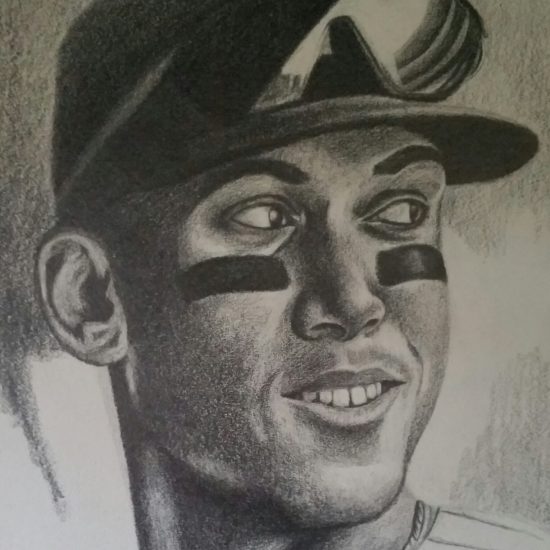This past offseason, Pitcher List introduced Pitch Level Value, or PLV, a new metric that assesses player performance by grading outcomes relative to the quality of the pitch. If you’re new to it, you can read Nick Pollack’s primer on PLV here.
You’ll find the definitions below. Grades are on a 20-80 scale.
Swing Aggression: How much more often a hitter swings at pitches, given the swing likelihoods of the pitches they face.
Strikezone Judgement: The “correctness” of a hitter’s swings and takes, using the likelihood of a pitch being a called strike (for swings) or a ball/HBP (for takes).
Decision Value (DV): Modeled value (runs per 100 pitches) of a hitter’s decision to swing or take, minus the modeled value of the alternative.
Contact Ability: A hitter’s ability to make contact (foul strike or BIP), above the contact expectation for each pitch.
Power: Modeled number of extra bases (xISO on contact) above a pitch’s expectation, for each BBE.
Hitter Performance (HP): Runs added per 100 pitches seen by the hitter (including swing/take decisions), after accounting for pitch quality.
Pitch Level Value (PLV): Estimated value of all pitches, based on the predicted outcome of those pitches (0-10, 5 is league average, PLV is not adjusted for pitch type).
Pitch Level Average (PLA): Value of all pitches (ERA Scale), using IP and the total predicted run value of pitches thrown.
Pitch type PLA: Value of a given pitch type (ERA scale), using total predicted run values and an IP proxy for that pitch type (pitch usage % x Total IP).
Velocity: Release speed of the pitch, out of the pitcher’s hand (in mph).
Release Extension: Distance towards the plate when the pitcher releases the pitch (in feet).
Induced Vertical Break: Vertical break of the pitch, controlling for the effect of gravity (in inches).
Arm-Side Break: Horizontal break of the pitch, relative to the pitcher’s handedness (in inches).
Adjusted Vertical Approach Angle (VAA): Vertical angle at which the pitch approaches home plate, controlling for its vertical location at the plate (in degrees).
xZone %: Predicted likelihood of the pitch being in the strike zone (as is called), assuming a swing isn’t made.
(Note: All stats are current through Thursday, 9/14).
Glasnow hasn’t missed a beat which is remarkable considering he was out really all of last season recovering from TJ and then missed time this year with an oblique injury. Regardless, he owns a 33.5% K rate through 18 starts which would be second only to Spencer Strider’s 37.6% among qualified SPs. And his 5.24 PLV is tied for 10th among all pitchers with at least 1,000 pitches.
A couple of home runs put a damper on his final line against the Twins this past Monday. However, it was another dominant showing from his slider (38 pitches) which recorded an eye-popping 5.92 PLV. His slider has shown some differences compared to the last time we saw him pitch for any length two years ago. Let’s take a look. (You can check out the pitch-analysis card app here and definitions are listed above)
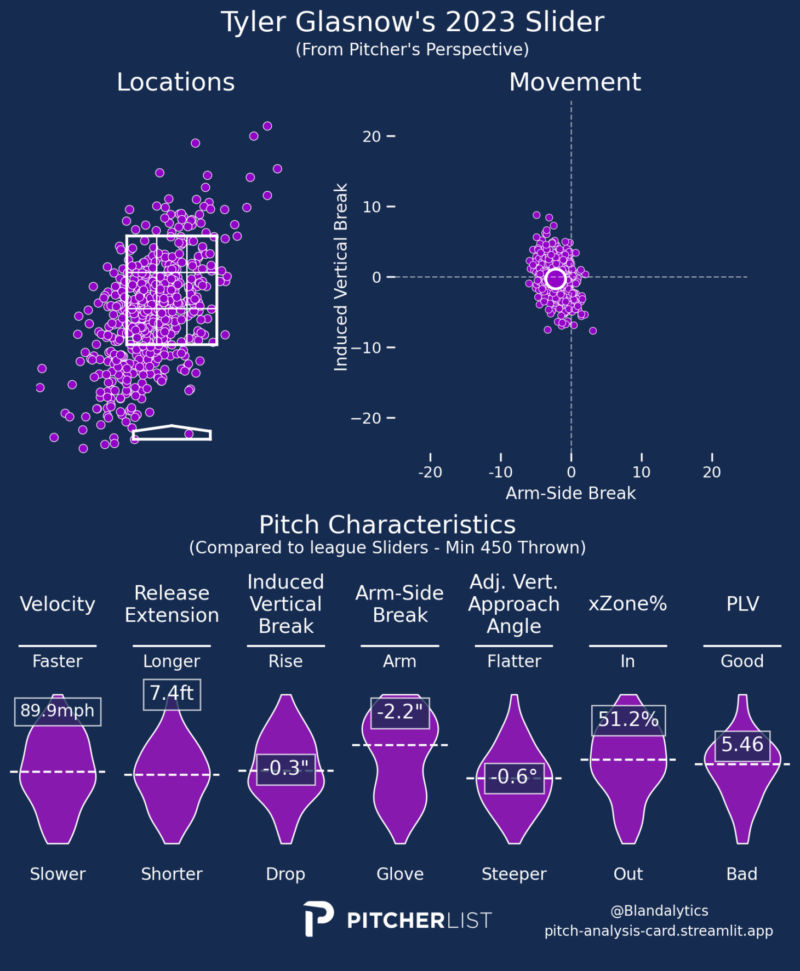
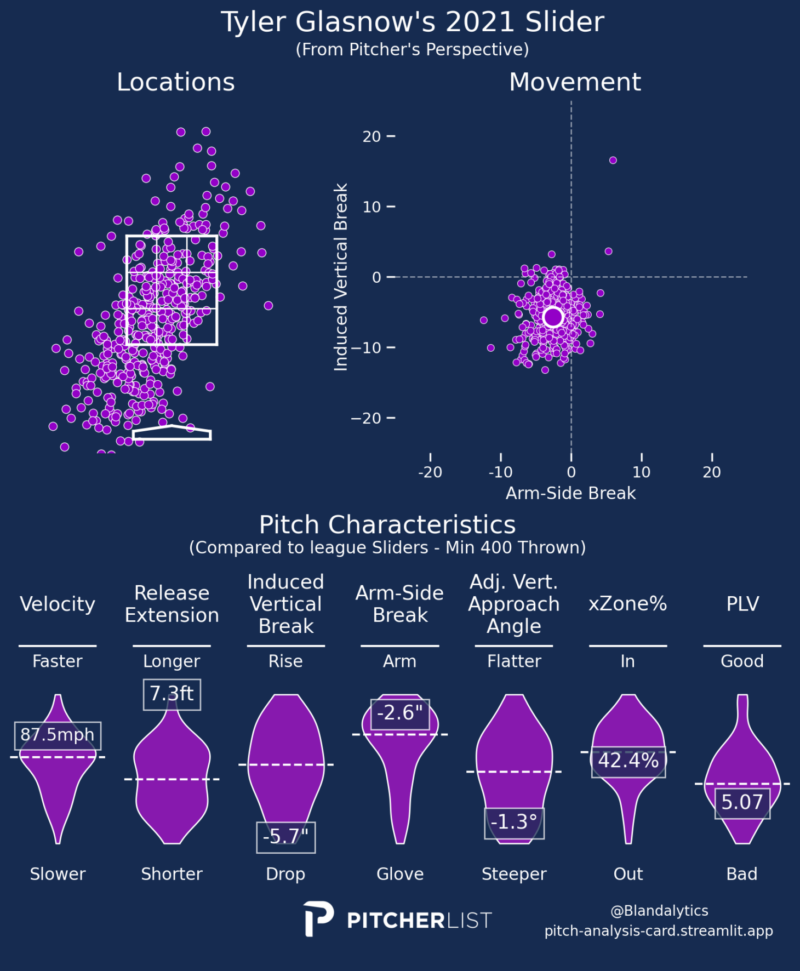
Not only is his slider nearly two and a half ticks quicker but it’s also shown far less induced vertical break (drop), so it’s operating much more like a gyro-type slider. He’s also throwing it for strikes far more frequently noted by an 8.8% bump in xZone %. All of it has added up to a big increase in PLV from 5.07 to 5.46 (or in PLA: 3.38 to 2.28).
Glasnow’s fastball, on the other hand, has not been quite as good in terms of pitch quality: its PLV has dropped from 5.34 to 5.14. (PLA: 2.61 to 3.30)
As far as his curveball goes, it hasn’t shown as much IVB this year (-15.5) compared to 2021 (-19.8) and it’s shown less arm-side break as well. The result has been a pronounced dip in its PLV from 5.52 to 4.99. (or in PLA: 2.11 to 3.72)
To put a bow on it all, Glasnow is once again awesome (no kidding) but it also seems like he’s doing it slightly differently than when we last saw him, i.e. his success appears to be more tethered to his slider (4% usage increase) and it’s a slider that appears to have some different characteristics. The other takeaway is that while he’s throwing his curveball more relative to 2021 (14% to 21%), its overall pitch quality hasn’t been quite as good as it was two years ago.
Another more salient detail is that he’s just six innings away from matching his career high of 111.2 from back in 2018. So the biggest question with Glasnow is how many innings will we see from him? Yes, you could probably say that about a lot of pitchers. Still, I think you’d be hard-pressed to find a greater risk/reward pick and I’m curious to see where he lands in early mocks.
While it’s true that Verlander hasn’t come close to replicating last year’s storybook Cy Young season, I don’t think anyone would’ve guessed he’d toss a clunker against the A’s like he did this past Tuesday. I certainly didn’t have Tony Kemp going yard against Verlander on my bingo card.
Overall, though, it looks like Verlander’s decline this year has been a product of his fastball; its PLV has dropped quite a bit and it’s now more toward the middle of the pack. You can get a better idea by looking at his distributions.
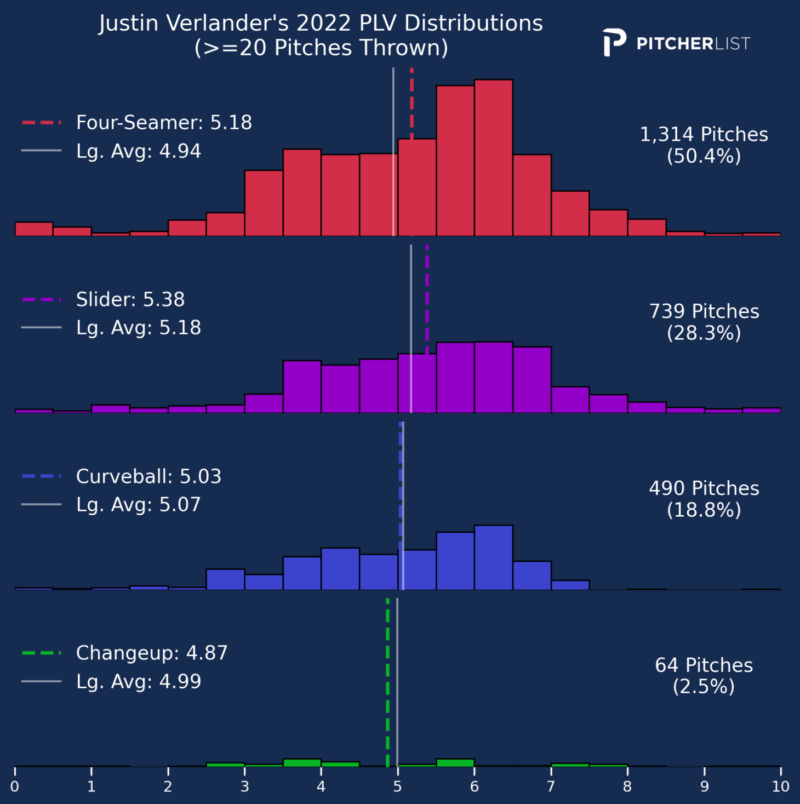
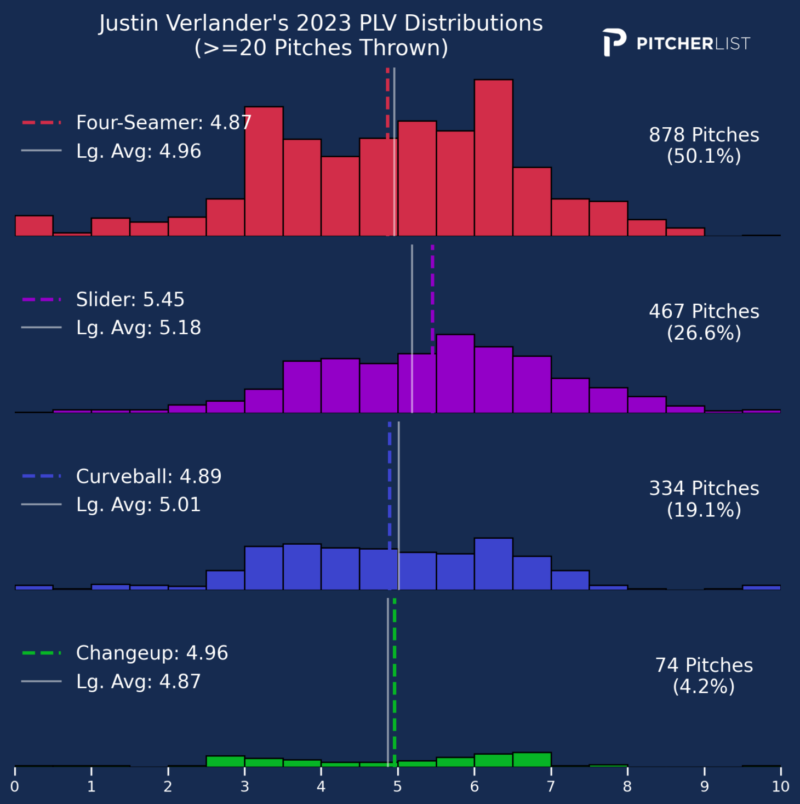
Remember when Garver hit 31 home runs back in 2019? It feels like ages ago but the veteran is proving that he’s got some thump left in his bat and is hitting .317 with a 1.106 OPS over his last 13 games.
Garver is a passive hitter (-9.3% swing aggression) who cuts a convincing profile: 65 in SZ judgment, 70 in power, and 70 in HP. He’s also demonstrated excellent swing decisions (65 in DV) that have improved over the year. He’s dealt with several injuries most notably right forearm surgery last year, so it’s good to see him back in action and the comeback looks absolutely legitimate. The man can still hit, that’s for sure.
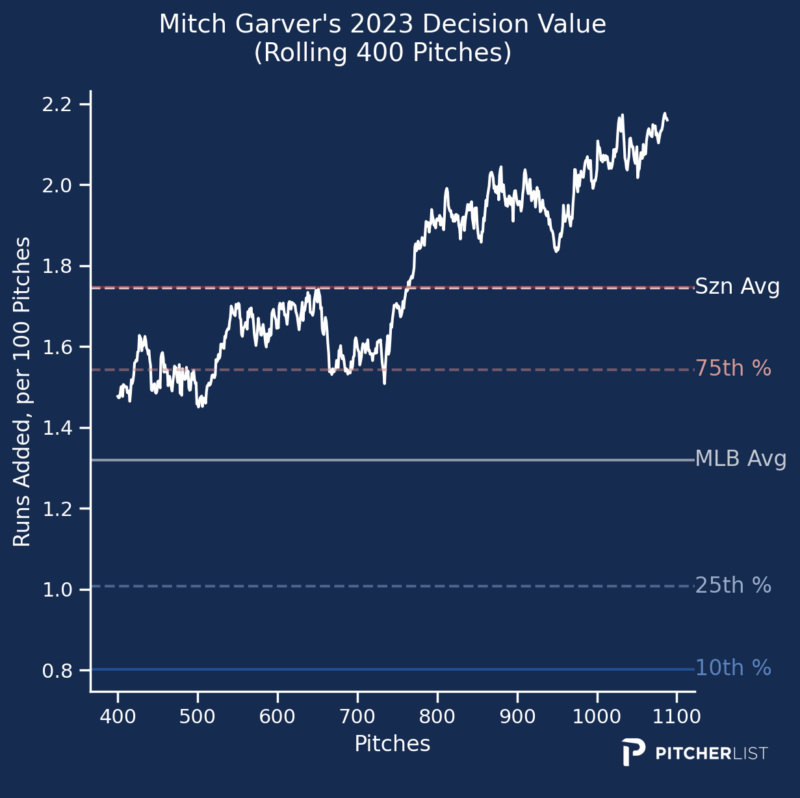
It’s been a terrific season for Peralta who after being beset by injuries a year ago has now reached a career-best 156.2 IP and 200 K’s. He handled the Marlins without much of a sweat and struck out nine while allowing one earned run on two hits. His slider (22 pitches, 5.67 PLV) and fastball (39 pitches, 5.74 PLV) were just about picture-perfect.
Overall, Peralta’s fastball (5.13 PLV to 5.32 PLV) and slider (5.06 PLV to 5.24 PLV) have shown marked improvements relative to last season.
We didn’t get to see Greene nearly as much as we wanted to this season but he put together a good showing last Sunday holding the Cards to one unearned run on one hit and four walks with nine K’s. His slider (50 pitches) led the way with a stellar 5.66 PLV.
Not only is Greene’s 4.43 ERA this season nearly identical to last year’s but his overall 5.15 PLV is almost a mirror image of last season’s 5.17; if you liked Greene heading into this year, you should probably still like him looking ahead to next year.
Blake Snell vs. Spencer Strider
Remember when Snell got off to that awful start early in the year? I don’t either. The two Cy Young front runners present an interesting dichotomy. Snell’s 2.43 ERA is backed by the second-best K rate among qualified SPs but also the highest walk rate, the highest LOB % of 85.9%, and the lowest batting average against (.186).
Strider, on the other hand, has the highest K rate among qualified SPs but his 3.73 ERA is backed by a mere 71.2% LOB and .206 batting average against. However, his walk rate is about half that of Snell’s. I’m admittedly a simpleton who prefers K-BB% so if I had a vote, it would have to be for the mustachioed right-hander.
But there’s only one way to settle this: What’s PLV say? In that case, it’s a landslide in favor of Strider’s 5.27 PLV over Snell’s 5.02 PLV.
Strider’s success is, of course, all about an overpowering fastball that’s earned a silly good 5.50 PLV.
Snell’s path to success this year, however, has been the result of a drastically improved changeup.
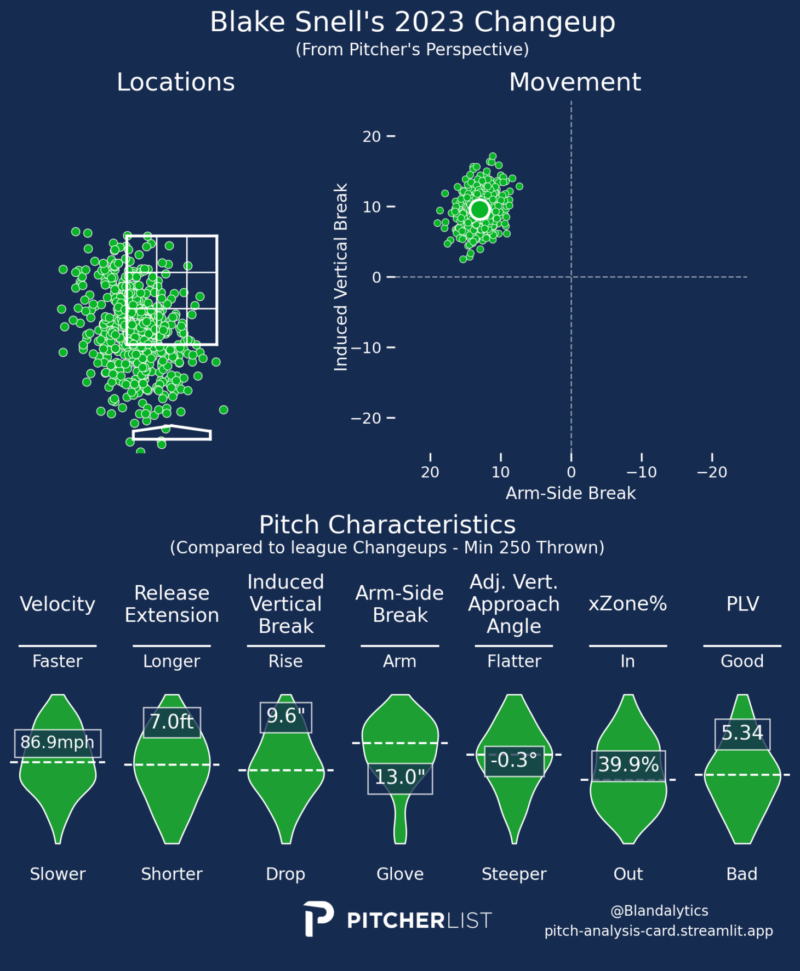
The physical characteristics of the pitch are fairly similar to last year. The big difference, however, has been in control: Snell’s changeup this year has an xZONE % of 39.9%, a drastic improvement over last year’s 21.6%. It’s resulted in a jump in PLV from 4.61 to 5.34. He’s also throwing the change 18% of the time as opposed to just five percent last year.
Speaking of changeups, Wacha’s changeup pitch-type PLA of 1.61 leads all pitchers with at least 1,000 pitches thrown. He got shelled in his latest start against the Dodgers but his slowball still earned a phenomenal 6.00 PLV during his ill-fated expedition to Chavez Ravine. Don’t ignore him as a potential streamer in a much more favorable matchup at home against Colorado.
The 24-year-old rookie right-hander has been on quite the roll of late for the Tigers with a 1.50 ERA, 0.83 WHIP, and a 26.1% K rate over his last four starts. However, his pitch quality metrics don’t paint a picture nearly as exciting as the results might suggest.
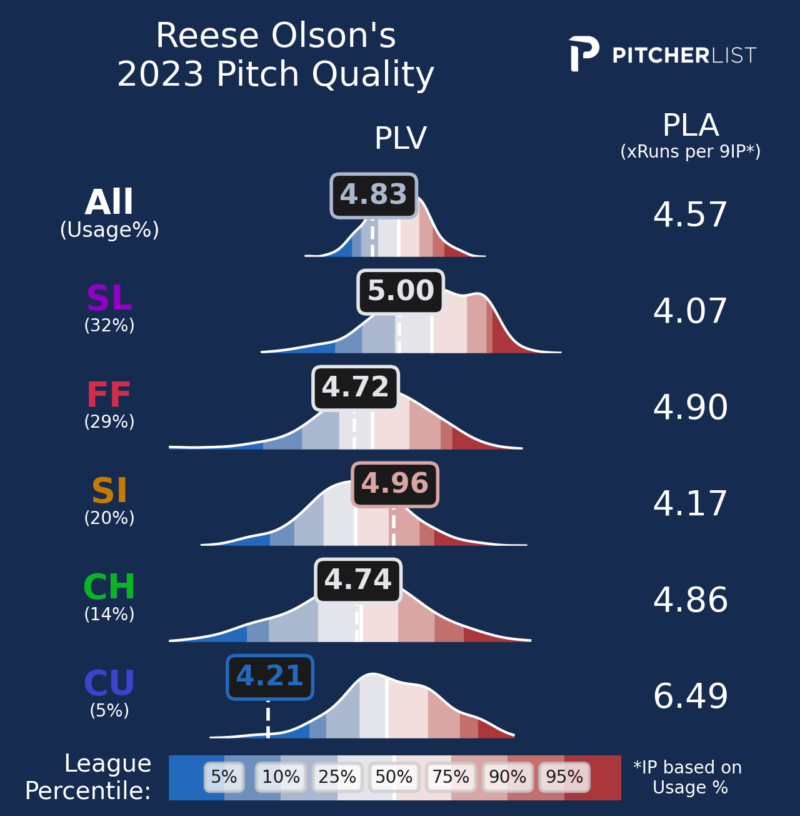
The Marlins traded for David Robertson at the deadline but he struggled and the club has since handed the closer keys over to Scott who has pitched brilliantly all year with a 2.21 ERA and 1.02 WHIP. The results are deserved as Scott’s 5.32 PLV is fourth-best among all pitchers with at least 1,000 pitches.
Falter has been used in and out of the ‘pen all year for the Phillies and now the Pirates so he’s easy to overlook. However, he had an impressive start during his last turn against the Nationals. I’m not sure if/when he’s getting another one but his overall 5.22 PLV is impressive, so he could be a decent dice roll in the final two weeks.
I mentioned him last week but he had his best outing yet in a hard-luck loss against the Red Sox at Fenway with eight K’s over four and two-thirds innings. The 87 pitches represent a high watermark for King and the outing earned a 5.26 PLV, so he’s certainly worth monitoring with an eye toward next year.
Photo by Joe Robbins/Icon Sportswire | Adapted by Justin Paradis (@JustParaDesigns on Twitter)

